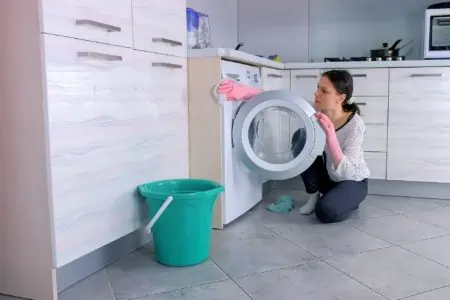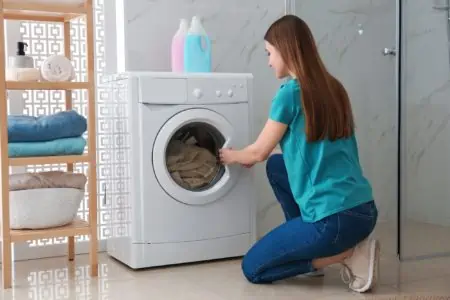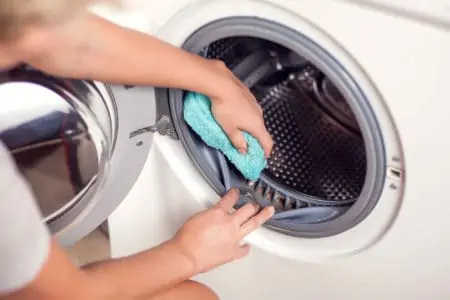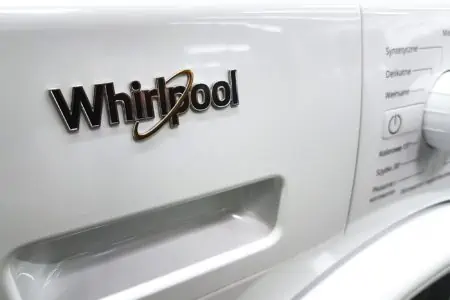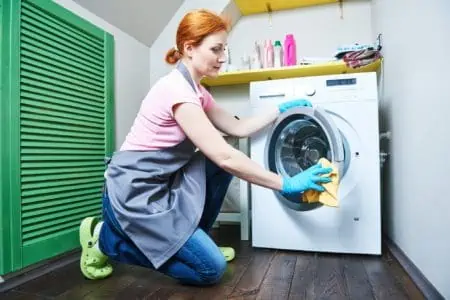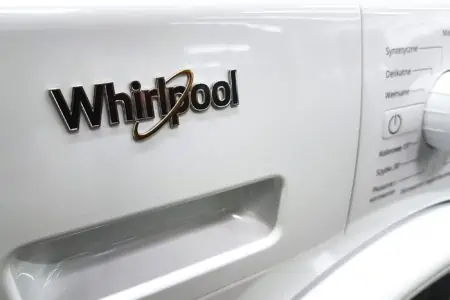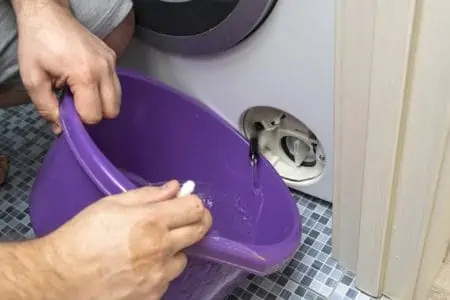Beep, beep. Your washing machine cycle is done. But you open the door to find that your clothes are still stinky and dirty. What’s up with that?
Did you know that you need to clean and sanitize your washing machine regularly? Just because it’s subjected to detergent and water every week doesn’t mean it’s self-cleaning.
Keeping your machine clean will keep your clothes clean. So it’s vital to know how to disinfect a washing machine. And that’s what we’re going to share with you. Keep reading for our two easy methods — with bleach and without bleach.
Key Takeaways
- Clean your washing machine monthly to prevent mold and soap scum buildup.
- Disinfect your washing machine using either bleach or a vinegar and baking soda solution.
- Run the machine on the hottest cycle for deep cleaning and sanitizing.
- Keep your washing machine dry and well-ventilated to prevent mold growth.
Why Is My Washing Machine So Dirty?
You might think that your washing machine should remain sparkling clean. After all, water and detergent run through it almost every day! But washing machines are subject to all kinds of gross elements, leading to a build-up of soap scum and mold.
Soap scum builds up in washing machines, especially for those who live in hard-water areas (1). The calcium and magnesium in the water react with your laundry detergent. This leaves behind a stubborn or sludge-like residue.
As for mold, it likes to grow in dark, damp places. If your washing machine doesn’t air out properly in between uses, or you leave clothes in there for a while, mold can begin to grow.
Another reason your machine can get so dirty is because of, believe it or not, detergent. It can leave behind a residue. If you use fabric softener, this is even more likely to leave behind a thick residue.
Last but not least, if you have an HE laundry machine but don’t use a specialized HE detergent, there won’t be enough water flow to rinse away the detergent properly.
You should dry out your washing machine between every use and deep clean it once a month.
How to Disinfect a Washing Machine
There are two fantastic methods for deep cleaning your washing machine. The first option utilizes bleach. Bleach is excellent at killing germs and disinfecting. If you have a mold issue, this might be the most effective method.
The second option uses vinegar and baking soda. This is the best non-toxic method. Baking soda and vinegar are old-school cleaning products, but we use them because they work! This is how we clean our washing machine, and we never have mold or soap scum issues.
- Time: 1-2 hours
- Difficulty: Easy
With Bleach
Let’s check out the bleach method first.
What You’ll Need:
- Chlorine bleach – such as Clorox
- Scrubbing brush
- Measuring cup
- Water
- Rubber gloves
- Protective mask
- Two cloths
1. Mix Bleach Solution
Before you start, put on your rubber gloves and mask. Bleach is a harsh cleaner, so it’s important to protect yourself.
Mix ¼ cup of chlorine bleach with four cups of water. Dip a scrubbing brush into the solution and gently scrub the rubber gasket, seals, and inner door of your machine. If you have buildup, work extra hard on these areas.
Move on to the detergent drawer when you’re done with these areas. Scrub until clean.
2. Run a Cycle With Bleach
Set the machine to the highest temperature. Some machines have a drum clean cycle. You can use that instead of manually choosing a cycle.
Add one cup of chlorine bleach to the empty drum. Don’t put it through the detergent drawer; otherwise, you will have bleach residue in your system. The next time you wash your clothes, some bleach might get onto them and damage your clothes.
Begin the cycle and let it run entirely. This will work wonders for those looking to sanitize a washing machine with mold and mildew.
3. Clean the Exterior
While the cycle is running, dip a cloth into your bleach solution from earlier. Wipe down the outside of the machine to disinfect it. Then, wipe it dry with a separate cloth.
4. Rinse Cycle
When the cycle finishes, open the door. You should notice that your machine instantly looks and smells cleaner. Run an extra rinse cycle with no added detergent or bleach to remove any bleach residue.
With Vinegar and Baking Soda
This is the DIY method we use at home, and it works like a charm every time.
What You’ll Need:
- 5 cups of distilled white vinegar
- 1 cup of baking soda
- Water
- Scrubbing brush
- Measuring cup
- 2 cloths
- Rubber gloves
1. Mix Baking Soda and Vinegar Solution
While these two are non-toxic, the vinegar is still acidic. That’s why we recommend wearing rubber gloves.
Mix one cup of distilled white vinegar, ½ cup of baking soda, and four cups of water. Dip a scrubbing brush into the solution and gently scrub the rubber seal, gaskets, and inner door of your machine. Make sure to apply extra elbow grease where you notice buildup.
Then move onto the detergent drawer, scrubbing until clean.
2. Run a Hot Cycle
Set your washing machine to the highest temperature or drum clean cycle.
For a front-loading laundry machine, add four cups of white vinegar to the detergent drawer and ½ cup of baking soda to the fabric softener compartment.
For top-loading machines, let the machine fill up for a few minutes before adding your four cups of white vinegar and ½ cup of baking soda. It might foam up, but that’s a good sign!
Run the entire cycle. For top-loading machines, you may want to pause it after the drum is full and let it soak for an hour before continuing.
3. Clean the Washing Machine Exterior
While the machine is running, dip a cloth into the vinegar baking soda solution from earlier. Wipe down the machine’s exterior to give it a deep clean. Wipe dry with a separate cloth.
4. Rinse Cycle (Optional)
Since it’s okay for vinegar and baking soda to get onto any fabric, you don’t need to complete a rinse cycle. Some people like to since vinegar has quite a strong smell. If you want, run an extra rinse cycle to remove any excess residue.
Sanitizing a Front Load Vs a Top Load Washer
With a top load washer, you can let the cleaning solution soak in the drum for longer. You can pause the machine and resume it later. This is a good hack if your drum is particularly filthy. It can loosen more residue, so it washes away easier.
Some front load machines also have a pause button. But if you pause, only a portion of the drum soaks in water. That’s why we recommend letting front-load machines run the entire cycle. If it’s still dirty, you can repeat the cycle or scrub the drum clean by hand.
Another notable difference is that with a top loader, you will need to clean the agitator. You may need to do this by hand. Use your cleaning solution and scrub the agitator with a bristle brush or cloth.
With a front load washer, you have the machine gasket to consider. This can get moldy if you don’t clean it regularly.
We recommend soaking microfiber cloths in your cleaning solution and applying them to the moldy areas of the machine, such as the rubber gasket. Leave it for 30 minutes before scrubbing the gasket clean.
How to Prevent Mold Growth In a Front Load Washer
The thought of mold growing in your washing machine is not pleasant. There are some easy ways you can prevent it. Try these hacks:
- Dry your washer: After each cycle, let the machine air dry by leaving the door open. Alternatively, you can manually dry the machine with a towel.
- Add a fan: An extractor fan or air conditioner can improve airflow in your laundry room, minimizing dampness on the inside of your machine.
- Remove wet clothes immediately: We know it’s easy to forget. But transfer the wet clothes to the dryer or clothesline as soon as you remember.
- Use the right detergent: Using the wrong detergent can make it hard for your machine to rinse it away effectively. This can cling to moisture, which in turn leads to mold.
As mentioned before, the best method is to sanitize the machine monthly. Now that you know how to clean a washing machine in a few simple steps, you can slot this chore right into your monthly chores.
How Do You Sanitize a Dryer?
Now that you know how to disinfect a washing machine, what about your tumble dryer? It must be sanitized and germ-free, too. Follow these steps:
- Remove lint: First, remove lint from the trap. Wash with warm water and air dry.
- Spray with all-purpose cleaner: Spray the dryer’s exterior with a cleaner, then wipe with a cloth. This will remove dirt and germs.
- Sterilize drum: Mix one gallon of cold water and ½ cup of chlorine bleach in a bucket. Wearing rubber gloves, dampen a cloth with the solution, then wipe the inside of the dryer, the door, the lint trap, and the exterior. This will sanitize your machine.
- Rinse: Dampen a separate cloth with plain water and wipe the same parts. This will remove the bleach residue.
- Dry old towels or rags: Toss in some old towels or rags, turn the dryer on high, and let it run for 10 minutes. This will absorb excess water and cleaning solution.
Now your dryer is clean and sanitized, and your whole laundry routine will feel way more hygienic than it did before!
FAQs
Sparkling Clean
Now that you know how to disinfect a washing machine and dryer, your clothes will instantly be fresher.
You can use bleach for a deep clean. But if you want to use a non-toxic cleaner, baking soda and vinegar will do the trick!
Disinfecting a washing machine only takes an hour or two. Do this monthly to maintain your machine and prevent mold and soap scum buildup.
